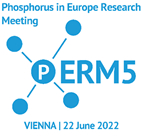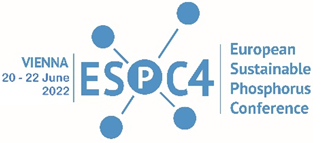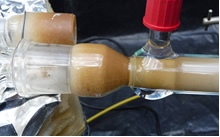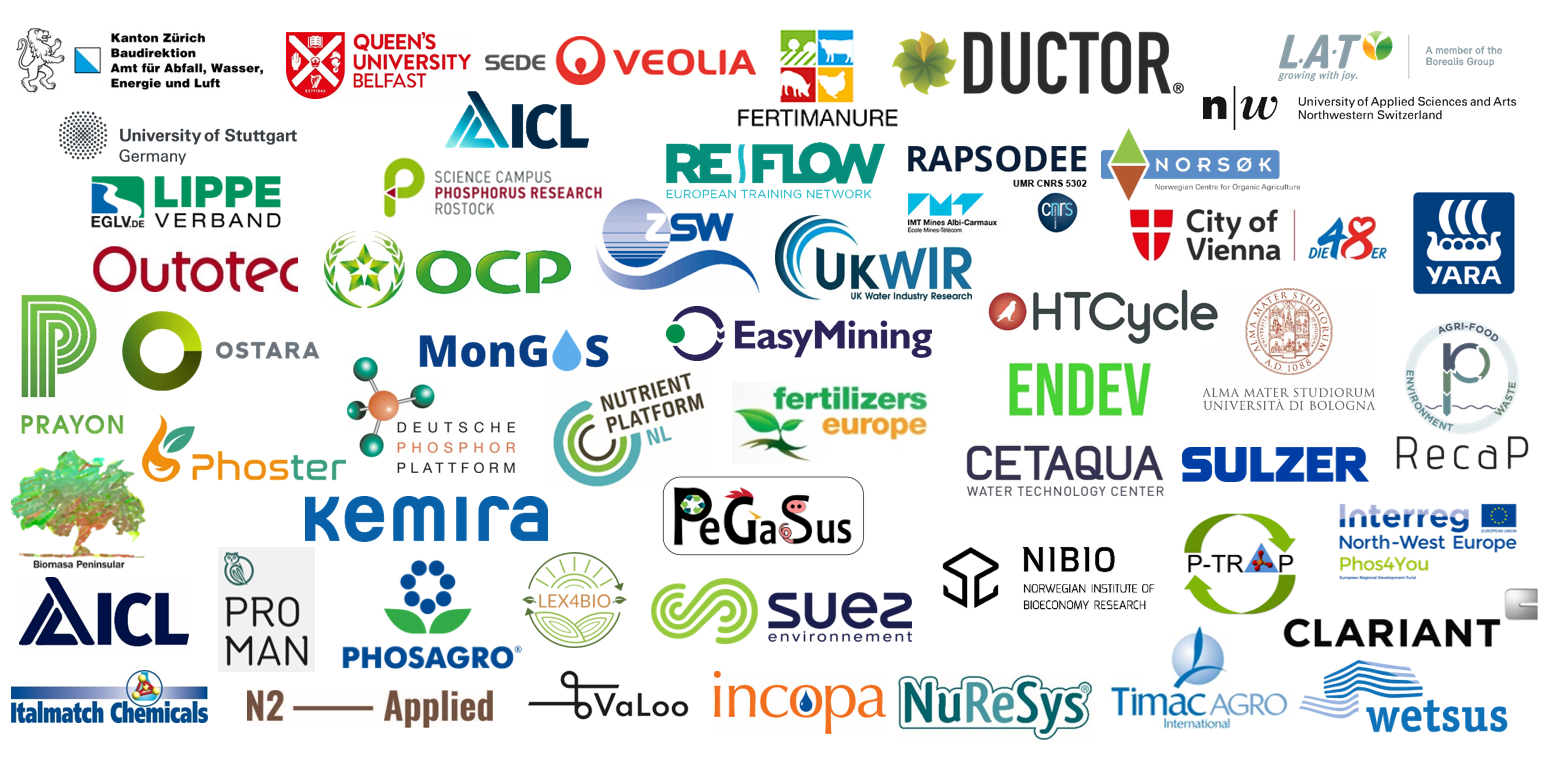Newsletter about nutrient stewardship - European Sustainable Phosphorus Platform (ESPP)
Please subscribe www.phosphorusplatform.eu/Subscribe
Link to www.phosphorusplatform.eu/eNews064
Download as PDF
War in Europe
ESPP job offer
Calls
PERM5 call for abstracts: phosphorus research and innovation
PERM5 session on fertilisers from dairy industrial wastes
Call for input: Legacy Phosphorus in Soils
Survey on biofertilisers
Phosphorus events
ESPC4 20-22 June 2022, Vienna Austria & online
Phosphates 2022
EU consultations
Digestate processing and other adjustments to the EU Fertilising Products Regulation
EU public consultation: mercury
EU public consultation: soil health
EU public consultation: biodegradable and biobased plastics
EU public consultation: antimicrobial resistance (AMR)
ESPP input submitted to EU consultation on the Waste Framework Directive
EU workshops on R&I needs to support soil and land use policies
Nutrient recovery
New process to recover White Phosphorus without coke or electric heating
Improving agronomic value of digestate nitrogen
Using ammonia for decomposing bio-plastic to fertilising products
Research
Climate change and environmental impacts of sewage works discharge
Recycling oyster shells to phosphate-based dental fillings
Waste biomass as carbon source for possible P recovery from steel slag
Biostimulants and bio-inputs to agriculture
Indicators for resource recovery in wastewater management
Global consortium to develop an open source database of crop nutrient removal
Stay informed
ESPP members
War in Europe
We cannot publish this eNews without expressing our deepest concern about the suffering of the people of Ukraine and the death and destruction caused by the war launched by the President of the Russian Federation.
This war is susceptible to have considerable impacts on fertiliser supply, and so ultimately on food production in Europe. Prices of fertilisers, already high (see “Supply challenges” ESPP eNews n°62), are expected to rise further, in particular nitrogen fertilisers because natural gas is used to produce ammonia. Russia and the Ukraine were in the past also respectively the world’s biggest and third or fourth (depending on the year) wheat exporters.
To ESPP’s understanding, as this eNews was published, fertilisers and food products are not directly concerned by EU trade sanctions on Russia implemented to date. However, sanctions to the Russian financial system, logistic or other factors may make trade difficult or impossible.
ESPP estimates that the EU, before the attack on Ukraine, imported over 1 billion € of phosphate rock or phosphorus value in fertilisers (including compound fertilisers, e.g. NPK). This is of a similar order to value of EU imports from Russia of aluminium or of steel, around 10 x lower than the value of the EU’s natural gas imports from Russia (see Politico 25/2/22). One estimate suggests that Russia accounted, before attacking Ukraine, for nearly 20% of global phosphate fertilisers trade (inc. compound fertilisers), and that 30% of Russia’s phosphate fertiliser exports are to the EU.
This is however nothing to the suffering of Ukraine and its citizens and the risks to global security.
ESPP job offer
 Open to 8h March. ESPP is looking to engage a Brussels representative, full or part time. Your role will be to develop networking, industry participation and Platform membership, including widening ESPP’s scope beyond phosphorus to recovery of nitrogen and other nutrients. We are looking for someone who can analyse and communicate technical, scientific and regulatory information on phosphorus, nutrients and recycling, who is motivated for environmental objectives and combines a business-development and an association consensus culture. Minimum 5 years’ experience and existing network. Employment could be as salaried staff, consultant status or shared staff with another organisation having similar objectives.
Open to 8h March. ESPP is looking to engage a Brussels representative, full or part time. Your role will be to develop networking, industry participation and Platform membership, including widening ESPP’s scope beyond phosphorus to recovery of nitrogen and other nutrients. We are looking for someone who can analyse and communicate technical, scientific and regulatory information on phosphorus, nutrients and recycling, who is motivated for environmental objectives and combines a business-development and an association consensus culture. Minimum 5 years’ experience and existing network. Employment could be as salaried staff, consultant status or shared staff with another organisation having similar objectives.
Full job description here www.phosphorusplatform.eu/joboffer2022
Send CV to by 8th March 2022.
Calls
PERM5 call for abstracts: phosphorus research and innovation
Call open to 8th March 2022.
 ESPC4, Monday 20th and Tuesday 21st June 2022, will be followed by PERM5, the 5th Phosphorus in Europe Research Meeting, Wednesday 22nd June 2022, making the link between R&D, industry and policy (summary of PERM4, June 2021, 370 participants, in SCOPE Newsletter n°141).
ESPC4, Monday 20th and Tuesday 21st June 2022, will be followed by PERM5, the 5th Phosphorus in Europe Research Meeting, Wednesday 22nd June 2022, making the link between R&D, industry and policy (summary of PERM4, June 2021, 370 participants, in SCOPE Newsletter n°141).
PERM5 sessions proposed include: nutrient recovery in the dairy industry, iron and phosphorus interactions, new fertilisers and biostimulants to improve crop nutrient uptake, Farm-to-Fork Zero Pollution: reducing P losses from agriculture, nature based solutions, decentralised sanitation / separative urine systems, nutrient flow studies …
PERM5 session on fertilisers from dairy industrial wastes.
Call open to 20th March 2022.
Presentations or posters are invited for a session on current and potential development of phosphorus fertilizers produced from dairy processing waste at PERM5, Vienna, 22nd June 2022. Deadline for this session (only) of PERM5 is extended to 20th March 2022. Papers on this theme already submitted will be considered (no need to resubmit). Abstract submission instructions are on the ESPC4 website. This session is co-organized by the MSCA European Training Network REFLOW (814258) focused on this area. The session will display research from various disciplines on the phosphorus flow from dairy industrial wastes back to soil. In addition to presentations and posters selected from abstracts received, the session will cover the use of enhanced biological phosphorus removal (EBPR) for dairy processing wastes, combined freeze concentration and membrane filtration for cheese whey treatment, hydrothermal carbonisation with struvite precipitation. Research on the field application of sludge and hydrochar fertilisers will show differences in emissions and recovered fertilizer impact. Results will show the implications of heavy metal contents on legal compliance of novel fertilizers recovered from dairy processing wastes. Research will cover sustainability assessments of the recovery system, from the treatment of the industrial wastewater to the use of the recovered phosphorus, including Life Cycle Assessments (LCA) assessments of multiple scenarios will also be presented.
Call for abstracts for PERM5 (22 June 2022, Vienna Austria & online) deadline 8th March 2022
(deadline for the dairy industry processing waste session: 20th March 2022)
Abstract submission instructions https://phosphorusplatform.eu/espc4
Call for input: Legacy Phosphorus in Soils
Over 560 participants joined the ESPP- BOKU webinar on the impacts of reducing “Legacy Phosphorus” in agricultural soils, 2nd February 2022, with a very active oral and online chat discussion. As proposed, ESPP will now engage a working group and workshop to write an operational definition of “Legacy P” (input is welcome). The webinar will be followed by SCOPE Newsletter special issue, summarising the webinar presentations and discussions, and also summarising a selection of scientific papers and other reports relevant to Legacy P.
Webinar presentation slides, video recording, Chat transcript are now available here www.phosphorusplatform.eu/LegacyP
Please send papers for consideration for inclusion to
Survey on biofertilisers
A user survey on biofertilisers is open by ELO, dlv, REFLOW, FertiCycle and Ghent University HERE. The aim is to collect information on user attitudes and willingness to pay for bio-sourced fertilisers. A survey on bio-based fertilisers was also organised by Fertimanure in 2021, see ESPP eNews n°53.
Phosphorus events
ESPC4
 20-22 June 2022, Vienna Austria & online
20-22 June 2022, Vienna Austria & online
https://phosphorusplatform.eu/espc4
Phosphates 2022
 7 – 9 March 2022, Tampa, Florida and online.
7 – 9 March 2022, Tampa, Florida and online.
The global phosphate industrial and business conference,
10% discount for ESPP members: request the code from ESPP.
CRU Phosphates 2022: https://events.crugroup.com/phosphates/home
EU consultations
Digestate processing and other adjustments to the EU Fertilising Products Regulation
Open to 9th March 2022, EU public consultation on conditions for authorising “post-processed” digestate, (including nitrogen recovery) in the Fertilising Products Regulation, and on various other technical adjustments. For digestates (CMC4 and CMC5) the proposed amendment, which follows from questions and proposals submitted to the European Commission by ESPP and EBA (European Biogas Association) enables certain post-processing of digestates (treatments after the anaerobic digester itself), that is, the use in CE-fertilisers of digestates conform to CMC4 or CMC5 criteria after:
- Mechanical solid - liquid separation, with use of up to 5% additives necessary for the solid-liquid separation, e.g. coagulants or polymers (subject to REACH registration of the additive where appropriate),
- Physical processing to remove water (where the process does not chemically modify the digestate),
- Removal of soluble ammonium to recover nitrogen.
ESPP notes that (to our understanding):
- Recovered nitrogen products (resulting from the ammonia removal above) are expected to be covered by the proposed new CMC15 (see ESPP eNews n°63) subject to purity and other requirements.
- Mechanical conditioning of digestate (fractions), such as drying (low or ambient temperature, solar), compacting, pelletising or granulation, removal of fibres … are not cited in the proposed amendments. ESPP will request that the eligibility of such processes, which are standard fertilising product conditioning processes, be clarified in the European Commission’s “Frequently Answered Questions” (FAQ).
- Addition of a chemical to adjust the pH of digestate is considered to be a combination of two CMCs (digestate fraction, pH additive chemical), that is the chemical itself must be CMC (e.g. CMC1).
- Non-mechanical post-processing treatments of digestate, such as ion removal by precipitation, ion exchange, adsorption, plasma treatment, electrostatic separation … are NOT covered by the amendments, and digestate (fractions) after such treatments cannot be included in CE-fertilisers.
ESPP notes that post-processing of composts CMC3 (e.g. dewatering) is NOT covered by the proposed amendments, presumably because the compost industry did not indicate that such processes could be relevant for placing composts on the market.
The other technical adjustments include text clarifications concerning nitrification inhibitors and specifying how efficiency is tested for such products (which aim to reduce nitrate leaching risk) and adjustments to ensure coherence with other existing EU texts or with the FPR itself: registration requirements for magnesia and for polymers, PCB limits in pyrolysis and gasification materials, conformity assessment of biostimulants.
EU public consultation open to 9th March 2022 “Fertilising products - technical amendments to the rules” HERE.
EU public consultation: mercury
Open to 3 May 2022. Consultation questions whether mercury should be banned in dental fillings and emissions from crematoria limited. Both actions would significantly reduce mercury levels in sewage and biosolids. Around 1/5th of global mercury use is in dental amalgam (fillings). Dental amalgam is the largest source of mercury to sewage biosolids, mainly from losses during use by dentists*. The European Commission states that in 2018 dental amalgam was the largest remaining application of mercury in the EU (following bans in electronics, thermometers, …) and that emissions from dental clinics have been reduced by an obligation to install filters. However, mercury in dental amalgam also reaches sewage and the environment with small emissions in urine and faeces** and in exhaled breath* of people with mercury in their teeth, and with significant emissions from crematoria originating from amalgam in teeth. The EU consultation documents cites OSPAR/HELCOM as identifying crematoria as a significant atmospheric emission of mercury, part of which will also reach sewage after falling back to land or water. To date, mercury is banned in amalgam for certain sensitive persons and alternatives exist (HCWH 2019). ESPP will input to the EU consultation supporting a ban on mercury amalgam (except in specific cases where there is no medical alternative) because mercury in sewage is an obstacle to some routes of reuse and recycling of sewage sludge nutrients and carbon.
* Vazquez Tibau “Mercury contamination from dental amalgam”, DOI citing Eureau 2016, US EPA 2019
** see e.g. Björkman 1997 DOI Dye 2005 DOI.
EU public consultation, open to 3 May 2022 “Mercury – review of EU law” HERE.
EU public consultation: soil health
Open to 16th March 2022. Call for evidence and input on orientations for a proposed EU Soil Health Directive, addressing questions including land take, nutrient losses, soil erosion, pollutant contamination. ESPP is preparing a submission to underline (subject to comments and input): that soil health is important to reducing losses of phosphorus and nitrogen to water (eutrophication) and that climate change will accentuate nutrient losses, the potential for returning organic carbon to land in nutrient recycling (digestates, composts, organic fertilisers), the importance of reducing or banning soil contaminants (e.g. PFAS, mercury). ESPP will also underline that a Soil Health Directive should ensure comparable constraints, including level cost playing field, for imported products, in order to avoid “export” outside the EU of soil degradation related to EU consumption of food, animal feed or consumer products.
To 16th march 2022 EU better regulation ‘Have your Say’ website LINK.
EU public consultation: biodegradable and biobased plastics
Open to 15th March 2022. ESPP will input that, to avoid obstacles to nutrient recycling, “biodegradable” plastics should be compatible with anaerobic digestion, and that plastic additives and microplastics should non-toxic. ESPP’s proposed position (open to comment) is that, because “biodegradable” plastics and microplastics are found in sewage sludge and food wastes, full degradability (to CO2 in composting or to methane in anaerobic digestion, or to agronomically valuable materials for return of nutrients and organic carbon to soil) should be required in both composting (in conditions of both industrial and household/garden composting) and in anaerobic digestion. Microplastics are a significant concern for contamination of organic waste streams and a potential obstacle to the nutrient Circular Economy and to the return of carbon to soils. EU chemical policy should phase out or restrict consumer or industrial chemicals which are found in microplastics or in sewage sludge and which pose potential toxicity or soil- or bio-accumulation issues. Should be addressed in particular PFAS/PFOS and other halogenated compounds, cadmium in artists paints, mercury in dental amalgam.
To 15th March 2022 “European Green Deal: Commission launches public consultation on biobased, biodegradable and compostable plastics” LINK.
EU public consultation: antimicrobial resistance (AMR)
Open to 24th March 2022. The proposed roadmap notes that inappropriate use of antibiotics in animals and humans is a key driver, but does not refer to implications for the Circular Economy due to contamination of manure and sewage. ESPP proposes (subject to comment and input) to input underlining that AMR in manure and sewage biosolids is a potential obstacle to nutrient recycling and to the return of organic carbon to soil, because of risk or perceived risk. ESPP proposes: as first priority to reduce inappropriate use of antibiotics, especially in livestock; to fix thresholds for antibiotic release from hospitals and livestock production; to develop where possible biodegradable antibiotic molecules, to harmonise reporting of AMR and to develop robust risk assessments of AMR in soil and crops; to develop processes to degrade and remove pharmaceuticals in sewage and manure treatment, including composting and anaerobic digestion.
To 24th March 2022, EU consultation “Antimicrobial resistance – recommendation for greater action” LINK.
ESPP input submitted to EU consultation on the Waste Framework Directive
ESPP underlined the need to improve (e.g. with legally binding targets) prevention and separate collection of food waste and organics, to facilitate nutrient recycling, and noted the need for clarification of definitions of biowaste, for example concerning food industry and animal feed processing wastes and sludges. ESPP pointed to studies suggesting that global food waste contributes 8% of anthropogenic greenhouse emissions, c. 60 000 tP/y lost in food waste for the EU27, phosphorus in food waste represents 120 days of nutrition P requirements, and that the P-footprint of food waste in China is c. 16% of fertiliser use.
EU public consultation on revision of the Waste Framework Directive, closed 22nd February 2022 LINK to submissions received.
EU workshops on R&I needs to support soil and land use policies
Workshops on 7th and 8th March 2022 (both 14h – 17h CET online) to validate the research gap analysis to define an R&I Roadmap for sustainable soil and land management for the Horizon Europe Mission “A soil deal for Europe”.
Register here. Soil Mission Support www.soilmissionsupport.eu
Nutrient recovery
New process to recover White Phosphorus without coke or electric heating
 STOWA has published a report on lab tests and thermodynamic modelling of Spodofos (Thermus BV), a new process to produce elemental P4 from secondary materials using waste aluminium as the energy source. Secondary aluminium (post-consumer, low quality) is heated to c. 600°C with a dry secondary material containing phosphorus, e.g. sewage sludge incineration ash, bone meal or precipitated phosphate salts. This causes a solid-solid, thermite reaction (exothermic), which raises the temperature to > 1800°C without further input of electricity nor coke. Unlike in conventional P4 reducing furnaces (using coke and electricity), pre-sintering of the input materials is not necessary, and carbon-monoxide is not generated. External heat energy is only needed for preheating the input materials, because of the intrinsic energy content of the secondary aluminium. The process has been tested at the lab scale (100g) and pilot development is now planned. The STOWA report concludes that feasibility is shown by thermodynamical modelling and expert evaluation of the laboratory experiments, but that additional tests may be needed to assess how the process can deal with iron (comes out as low value by-product, ferrophosphorus) and contaminants such as zinc, copper, arsenic. Scale-up will require development of specific reaction mixture conditioning and furnace. Economic feasibility will probably depend on the price of the aluminium scrap and the possible value of the high aluminium slag generated, in which contaminants are immobilised by high-temperature vitrification.
STOWA has published a report on lab tests and thermodynamic modelling of Spodofos (Thermus BV), a new process to produce elemental P4 from secondary materials using waste aluminium as the energy source. Secondary aluminium (post-consumer, low quality) is heated to c. 600°C with a dry secondary material containing phosphorus, e.g. sewage sludge incineration ash, bone meal or precipitated phosphate salts. This causes a solid-solid, thermite reaction (exothermic), which raises the temperature to > 1800°C without further input of electricity nor coke. Unlike in conventional P4 reducing furnaces (using coke and electricity), pre-sintering of the input materials is not necessary, and carbon-monoxide is not generated. External heat energy is only needed for preheating the input materials, because of the intrinsic energy content of the secondary aluminium. The process has been tested at the lab scale (100g) and pilot development is now planned. The STOWA report concludes that feasibility is shown by thermodynamical modelling and expert evaluation of the laboratory experiments, but that additional tests may be needed to assess how the process can deal with iron (comes out as low value by-product, ferrophosphorus) and contaminants such as zinc, copper, arsenic. Scale-up will require development of specific reaction mixture conditioning and furnace. Economic feasibility will probably depend on the price of the aluminium scrap and the possible value of the high aluminium slag generated, in which contaminants are immobilised by high-temperature vitrification.
STOWA (Netherlands water boards’ joint research foundation) report (in Dutch) 5th January 2022
Improving agronomic value of digestate nitrogen
N2 Applied (an ESPP member) starts plasma treatment at More Biogas’ plant, Småland, Southern Sweden, a 90 000 t/y manure and food waste plant, where N2 Applied stabilises and enhances nitrogen in the liquid fraction of digestate. This produces a stable agronomic product adapted to farmers needs and crop nutrient requirements. This is with the BalticWaters2030 project “Circular NP” and with the More Biogas company, owned principally by some twenty chicken, pig and cow farmers around Förlösa, Läckeby and Rockneby north of Kalmar, Sweden. The N2 Applied process (see ESPP-DPP-NNP Nutrient Recovery Technology Catalogue) uses electricity (preferably renewable) to stabilise nitrogen in organic wastes (manure, digestate …) to ammonium nitrate, by combination with atmospheric N2, so also enhancing the nitrogen content (better balancing nutrients to plant requirements), lowering pH and reducing ammonia and greenhouse emissions. In addition to this nitrogen-rich liquid fertiliser, the NP project aims to develop a phosphorus-rich solid organic fertiliser product from the solid fraction of the digestate.
Circular NP project, with Horizon2020, Baltic Waters, SLU (Swedish Agricultural University), RISE Sweden, Swedish Farmers' Foundation for Agricultural Research https://n2applied.com/2021/11/24/more-biogas/
Using ammonia for decomposing bio-plastic to fertilising products
Ammonia is shown to completely degrade the bio-based polymer PIC to produce urea and the isosorbide monomer (ISB, a sugar). The resulting urea + ISB showed to be an effective fertiliser, with the ISB enhancing plant nitrogen use. PIC, poly (isosorbide carbonate), is a bio-based plastic based on isosorbide (ISB), which is derived from glucose. Tests showed complete degradation of PIC to ISB by reacting with aqueous ammonia solution at 90°C for 6 hours, without solvent or catalyst. Such ammonolysis (using ammonia to break down polymers) is a known reaction. This study showed that the resulting material, a mixture of urea and ISB monomer, could be directly used as a fertiliser in pot trials with Arabidopsis thaliana (thale cress). The generated material showed the same N-fertiliser effectiveness as commercial urea, and the ICB enhanced the fertiliser effectiveness, presumably acting as a biostimulant. ESPP notes that these results may not transpose to more widely used or synthetic polymers, and that it could be considered preferable to re-use the ISB monomer in plastics production rather than putting it on soil. The title of the paper is misleading in that the nitrogen is not recycled but comes from ‘virgin’ ammonia.
“Plastics to fertilizers: chemical recycling of a bio-based polycarbonate as a fertilizer source”, T. Abe et al., Green Chemistry issue 22, 2021 DOI.
Research
Climate change and environmental impacts of sewage works discharge
Modelling in Central – Western Europe suggests that climate change will result in significant ecological risk from discharges from sewage works into smaller waterways for phosphorus, and especially for ammonia. The study was based on data from the Rhine, Elbe and Weser catchments, which have significantly differing climate and hydrological responses, excluding Switzerland (which does not report data to the EU) and France (nutrient discharge data not reported), covering around 3200 sewage works (wwtps) in Germany, Czech Republic and The Netherlands. Sewage works were classified into five sizes (population served). Sewage works discharge was matched to river flow at wwtp discharge point, based on a 5 km grid hydrological model (mHM) and the GFDL(ESM2M/RCP8.5 3K greenhouse warming scenario. Results suggest that wwtp discharge will cause ecological risk to prevail in the future in smaller watercourses, for all sizes of wwtp (and in particular for wwtps 5 000 – 100 000 p.e.).. The risks from ammonia discharge were highest because of emissions from smaller wwtp. The authors conclude that sewage treatment legislation needs to strongly take into account the capacity of the receiving watercourse (ESPP note: this is the case in the Water Framework Directive, but not in the Urban Waste Water Treatment Directive) and that regulation should be developed for ammonia in discharges from small wwtps.
“What Determines the Future Ecological Risks of Wastewater Discharges in River Networks: Load, Location or Climate Change?”, S. Yang et al., EarthArXiv preprint 2022 https://doi.org/10.31223/X5X062
Recycling oyster shells to phosphate-based dental fillings
Sintered oyster shells were reacted with phosphoric acid to produce hydroxyapatite (HAP = calcium phosphate) then combined with zinc phosphate to produce a dental cement material. Calcium phosphate is the main constituent of bones and teeth and hydroxyapatite can bond onto this. Here, HAP was produced by cleaning, grinding and then sintering (900°C) waste oyster shells (Crassostrea madrasensis) to produce CaO, which was then reacted with phosphoric acid with pH maintained at 8 – 10 to control the Ca:P stoichiometric ratio. The precipitated HAP was then again sintered at 800°C resulting in a material similar to Ca5(PO4)3(OH)2.. Zinc phosphate was prepared by reacting zinc metal with phosphoric acid. The zinc phosphate and HAP were then ceramified at 1000°C with traces of magnesium, silicate and aluminium, with mixtures of 0 – 50% HAP / 100 – 50% zinc phosphate. Lab tests suggested that the recycled HAP was comparable to commercial HAP and could be incorporated into zinc phosphate dental cement, maintaining or improving mechanical properties and elution (risk of dissolution of the filling in the mouth).
“Development of a Novel Dental Filling Using Hydroxyapatite Derived from Waste Oyster Shells”, M. Uresha et al., J. Technology and Value Addition, Volume 3 (1), 2021: (1-18) LINK.
Waste biomass as carbon source for possible P recovery from steel slag
Risk husk waste, after pyrolysis, showed to remove c. 80% of phosphorus from synthetic steel slag with c. 4%P at 1500°C, but the resulting phosphorus was bound to iron so would not be directly useable as a fertiliser. The waste rice husk from agri-food industry was first carbonised (pyrolyzed) by heating to 450 – 600 °C in anoxic condition, to increase its carbon content and reactivity. It was then mixed with 20g of synthetic steel slag (industrial steel slag was not used because of its high variability) and heated to 1500°C for 30 minutes with a 3:1 carbon:P ratio (c. 10:1 carbonised rice husk:P).The iron depleted slag could be used as a raw material for steel production, with high calcium and silicon, so without pre(slagging. The phosphorus was removed from the slag as particles of iron-phosphorus compounds, mainly Fe3P, with P content of 2 – 12 %. The authors suggest that this could processed to fertiliser (citing Morita 2002).
“Effective removal of phosphorus from high phosphorus steel slag using carbonized rice husk”, Z. Wang et al., J Environmental Scient 124(2023) 156-164 DOI.
Biostimulants and bio-inputs to agriculture
Workshop of over 250 participants concludes the need for more biologically integrated agriculture and harmonised regulations and definitions for biostimulants, biological crop protectants and soil improvers. The workshop proposed a definition of ‘bio-intensification’ as achieving adequate yields from minimum land area by increasing and sustaining biodiversity and soil fertility. Biostimulants and soil improvers were defined as per the new EU Fertilising Products Regulation (2019/1009). Bio-protectants were defined as various biocontrol agents (including “botanicals” – which are not defined in the article). Definitions clearly do pose a problem, in that the article uses the term ‘bio-fertiliser’ to mean ‘bio-stimulant’, whereas many authors use this term to mean fertilisers derived from biological materials or organic wastes. The article notes that the EU Fertilising Product Regulation defines ‘biostimulants’ by the claim to “stimulate plant nutrition processes” but without requirements of efficacy or composition. Bioprotectants, on the other hand, face high registration costs under the EU 1107/2009 (Plant Protection Products). Nonetheless, there are over 1 600 such products on the market in the EU, nearly 90% of which from SMEs (source: IBMA International Biocontrol Manufacturers Association). Overall, the workshop concluded that bio-inputs inputs cannot completely replace agrochemicals without changing farm production systems.
“Biostimulants, soil improvers, bioprotectants: promoters of bio‑intensification in plant production”, F. Feldmann et al., J. Plant Diseases and Protection, 2022 DOI.
Indicators for resource recovery in wastewater management
The Circular Economy Monitoring Framework does not to date consider resources from wastewater. This paper summarises literature, outlines key questions and proposes indicators for wastewater treatment circularity. Identified publications on indicators related to the wastewater sector have significantly increased since around 2014, with very 0 - 2 per year before that, up to 20 in 2021. Identified indicators include wastewater treatment (e.g. organic matter removal), chemical usage in treatment, biogas production, nutrient recovery. Recommendations are made for the design of indicators of wastewater management circularity: address both local and global dimensions of circular economy, need for a range of indicators enabling selection of indicators relevant for a given context (e.g. quality and contaminant indicators relevant for sewage sludge will be different if the destination is incineration or land valorisation), use of appropriate units, coverage of the whole wastewater generation - collection - treatment cycle. A simple proposed indicator set is outlined: rate of recovery of nutrients (N and P), rate of recovery of organic matter (valorised to soil), reuse of treated wastewater (internally within the wwtp or for fertigation or other local needs), energy self-sufficiency (taking into account energy produced). It is noted however that questions such as bio-availability of recovered nutrients should also be considered. The weighting of different indicators will depend on the local situation (e.g. in some regions water reuse is more important than in others). The authors note that the development of appropriate and recognised indicators of wastewater management circularity is important to increase business and social awareness and acceptance of recycling of wastewater-derived materials and to support public policies for nutrient recycling.
“Indicators for resource recovery monitoring within the circular economy model implementation in the wastewater sector”, M. Preisner, M. Smol et al., J. Environmental Management 304 (2022) 114261 DOI.
Global consortium to develop an open source database of crop nutrient removal
The Consortium for Precision Crop Nutrition (CPCN), whose members are over 30 fertilisers companies, agricultural R&D institutes and global organisations, are collaborating on an open source, global crop nutrient removal database. The database will be used to improve estimates of crop nutrient removal and nutrient use efficiency at local to global levels. Input of field experiment data is invited.
Contact Wageningen WUR scientist Cameron Ludemann
Stay informed
SCOPE newsletter: www.phosphorusplatform.eu/SCOPEnewsletter
eNews newsletter: www.phosphorusplatform.eu/eNewshome
If you do not already receive SCOPE and eNews (same emailing list), subscribe at www.phosphorusplatform.eu/subscribe
LinkedIn: https://www.linkedin.com/company/european-sustainable-phosphorus-platform/
Slideshare presentations: www.slideshare.net/NutrientPlatform
Twitter: @phosphorusfacts
ESPP members

